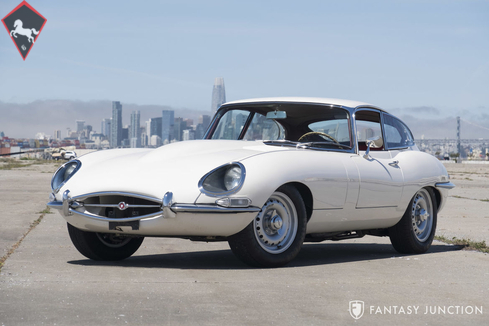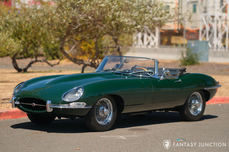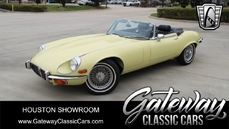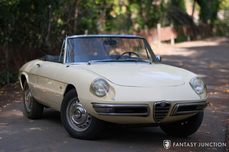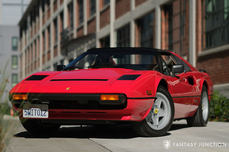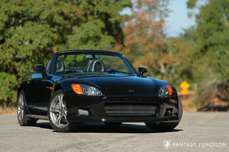Jaguar E-type 4.2L DOHC Inline-6 1967
Allgemeine Beschreibung :
1967 Jaguar XKE Coupe
Chassis Number – 1E-33790
Engine Number – 7E 11003-9
Body Number – 4E 25289
Exterior Color – Ivory White
Interior Color – Red leather
Engine – 4.2 Liter DOHC in-line six-cylinder engine
Gearbox – 5 speed all synchromesh manual
Current Miles – 34,347 believed original miles
Highlights
Exceptionally low mile car with sensitive mechanical updates
Numbers matching engine and head
Partial original paint with sensitively blended areas
Original carpets, rear storage area, door panels, dash, and headliner
Seats professionally restored and reupholstered in 2005
Modifications from Stock
Triple 45 DCOE 15 Weber carburetors
Darrington steering wheel (Triumph TR-4 type)
Stainless steel exhaust system
GAZ rear shock absorbers
Borg-Warner 5-speed manual gearbox
Tubular exhaust headers
Dunlop Alloy bolt on wheels
Alloy radiator
Alloy Flywheel
Heavy duty front and rear sway bars
Wilwood four piston caliper front disc brake conversion
Engine rebuild 2005 (26,800 miles) with performance upgrades
General History
Unveiled at the 1961 Geneva Motor Show, the Jaguar E-type delivered a totally new approach to sports cars. Stunning design, unrivaled performance, and racing lineage made the E-Type an immediate sensation. With its beautiful lines and surprisingly affordable price, the E-Type garnered its iconic status where it continues to reign at the top of collector and enthusiast lists. Independent front and rear suspension, disc brakes all around (inboard at the rear to reduce unsprung weight), and Jaguar’s legendary twin-cam inline six-cylinder engine were just part of the allure. Sales were brisk with growing interest in both American and European markets. Although the E-Type would continue into the mid 1970s, enthusiasts today remain steadfast regarding their admiration for the Series 1 models as one of the most beautiful and capable sports cars ever conceived.
Current Condition and Ownership
In the 1980s, this car was offered at the Barrett-Jackson Auction, AZ. Viewing cars that day with Bruce Trenery, proprietor of Fantasy Junction, Emeryville, CA, Bob Cole (Cole European Motors) inspected the car together, but the car remained unsold at the auction. Eventually, Cole approached the son-in-law of the original owner and privately purchased the car. After modest use, Cole sold the car to renowned Ferrari collector Brandon Wang, a fan of originality and preservation. In 2003, Wang arranged for a trade and partial payment on a Ferrari with Bruce Trenery. Recalling his former ownership, Trenery notified Cole who purchased the car for a second time. In 2005, Cole embarked on a series of professional performance modifications to prepare the car to a very capable road going standard while retaining as many of the original features and general character of the E-Type as possible.
Mechanical Restoration
Having been preserved and maintained through the early years of its life, this E-Type was showing approximately 27,000 miles when it was prepared by XKs Unlimited under commission from the consigning owner, who then spent upwards of $50k on the car to rebuild the engine to a high level of performance, in preparation for vintage driving events. The shop prepared the engine with extensive performance components including Venolia pistons, Carrillo rods, performance cams, alloy flywheel, performance damper, a big valve conversion, an alloy radiator, Weber intake manifold and carburetors, a new fuel rail, and an electronic distributor. Both the original head and original block were sent out for professional machine work to the surfaces and bottom end. During this time the front seats were removed, stripped of the old foam, and the frames refinished. New foam was installed, along with new red leather for the seats, while the remaining interior including the original carpets were retained, cleaned, and conditioned. Other work included the installation of a new windshield, a new retractable-type radio antenna, new inner workings for the clock, and the front suspension was rebuilt with new poly bushes, new ball joints, solid rack mounts, and heavy-duty front and rear sway bars.
Continuing with the updates to the mechanical systems a stainless-steel exhaust system was installed from the headers back and a set of Dunlop bolt-on hub alloy wheels were fitted. A 5-speed gearbox was fitted to the rebuilt engine and a new clutch, throwout bearing, and lightened flywheel were installed. Other improvements included GAZ rear shock absorbers and new coil overs, and four piston Wilwood front calipers with drilled and slotted discs.
Cosmetic presentation
Today the overall exterior is very satisfying with a very handsome mixture of original finishes and sensitively updated features. The finish shows typical areas of use including stone chips, slight paint discoloration to the blended paint areas, and minor stress cracks, notable only upon close inspection. The lighting, lenses, and glass appear very clean and preserved throughout. The body integrity is sound, with good panel gaps on the rear hatch, and bonnet, while the door fit appears quite good especially considering the originality of the body. The chrome window and side glass surrounds are in very good original condition overall, remarkably so being original to the car. The front and rear bumpers are very nice as are many of the rubber gaskets throughout the car. The Dunlop wheels feature chrome plated knock offs with excellent finish and add a sporting presence to the elegant design.
The red leather interior is original with the exception of the seats, which were professionally restored and recovered in 2005. The original carpet is in remarkably nice condition. The dash pad is in very fine shape indicating that this car must have enjoyed indoor storage throughout even early life as there is no evidence of sun damage. The instruments are beautifully preserved with excellent faces and contrasting color. The original door panels, matching covered door sills, headliner, and rear storage area are quite nice in both condition and material quality, again preserved and saved from the elements. Although the seats have been re-upholstered, the leather has matured just enough over the past fifteen years to now feel very much in keeping with honest and harmonious appearance of this E-Type.
The engine compartment is correct in appearance and properly detailed. The Weber carburetors are a nicely balanced feature of the engine without appearing out of character. Both the engine numbers are evident and matching as is the “picture frame” support section bearing the correct chassis number, both of which correspond correctly to the data plate affixed to the car. The undercarriage appears clean, tidy, and very much in keeping with the stated miles. The body seams, weld lines, and joinery are further indicative of original construction while modest updates appear properly performed without modification to the original integrity of the car.
Included with the car
The car is accompanied by an original owner’s pouch, operating manual, dealer listing manual and maintenance voucher book, an original jack, jacking bag, knock-off hammer, a complete set of tools and tool roll. Also included with the sale is a set of floor mats and two copies of the fold-up Jaguar E-Type Maintenance Chart.
https://fantasyjunction.com/inventory/1967-jaguar-ba-t-auction-preview-xke-fixed-head-coupe/overview
1967 Jaguar E-type 4.2L DOHC Inline-6 is listed verkauft on ClassicDigest in Emeryville by Fantasy Junction for Preis nicht verfügbar.
Fakten der Auto
Karosserietyp : Auto Marke : Jaguar Modell : E-type Ausführung : 4.2L DOHC Inline-6 Hubraum : 4.2 Modelljahr : 1967 Lage : Emeryville Fahrzeug Anmeldung : Normal
Verkauft
Angaben Zum Verkäufer
Verkauft
People who viewed this Jaguar E-type also viewed similar Jaguar listed at ClassicDigest
Other cars listed for sale by this dealer
über Jaguar
Ah, die Geschichte von Jaguar, von seinen Anfängen als SS Cars Ltd. bis hin zum Höhepunkt mit dem D-Typ und der Straßenversion des ikonischen E-Typs. An dieser Erzählung haftet etwas zutiefst Britisches, und ich werde sie erzählen, wie es ein britischer Journalist tun würde.Die Anfänge:
Unsere Reise in die Welt von Jaguar beginnt in den 1930er Jahren, als ein Unternehmen namens SS Cars Ltd. auftauchte. Trotz des unglücklichen Zufalls ihrer Initialen, die mit den aufkommenden politischen Spannungen in Europa zusammenfielen, begannen sie, stilvolle und leistungsorientierte Autos herzustellen. Der SS 100, der 1936 eingeführt wurde, war ein Symbol für Eleganz und Geschwindigkeit und legte den Grundstein für das, was Jaguar werden sollte.
Die Geburt von Jaguar:
Als der Schatten des Zweiten Weltkriegs näher rückte, entschied sich SS Cars Ltd. klugerweise, sich von den SS-Initialen zu distanzieren. So wurden sie 1945 offiziell zu Jaguar Cars Ltd., ein Name, der bald für britischen Luxus und Leistung stehen würde.
Die XK-Serie:
Die Nachkriegszeit von Jaguar brachte uns den XK 120, eine wahre Sensation im Jahr 1948. Mit seinem schlanken Design und einem leistungsstarken 3,4-Liter-Sechszylindermotor wurde er zum schnellsten Serienauto der Welt. Der XK 120 war die Blaupause für das, was kommen würde - Jaguars, die Stil mit Geschwindigkeit auf einzigartig britische Weise verbanden.
Die Dominanz des D-Typs:
Dann kam der D-Typ, eine wahre Rennlegende. 1954 eingeführt, gewann er in den 1950er Jahren dreimal Le Mans und zeigte die technische Kompetenz von Jaguar. Mit seiner innovativen Monocoque-Konstruktion und der ikonischen Finne hinten war der D-Typ der Höhepunkt von Jaguars Motorsporterfolgen.
Das Auftauchen des E-Typs:
Aber der wahre Wendepunkt kam 1961 mit der Einführung des E-Typs, oft von Enzo Ferrari als "das schönste Auto, das je gebaut wurde" bezeichnet. Seine lange Motorhaube, die geschwungene Karosserie und ein 3,8-Liter-Motor, der atemberaubende Leistung lieferte, machten ihn sofort zu einem Klassiker. Der E-Typ war nicht nur ein Auto; er war ein Kunstwerk auf Rädern und konnte auf der Straße 150 Meilen pro Stunde erreichen.
Straßen- und Rennsporterfolge:
Die Schönheit des E-Typs wurde durch seine Leistung auf der Rennstrecke unterstrichen. Die leichten E-Typen waren bei verschiedenen Rennveranstaltungen besonders erfolgreich und festigten den Ruf von Jaguar als eine Kraft, mit der man im Motorsport rechnen musste.
Das Zeitalter der Raffinesse:
Je tiefer wir in die Geschichte von Jaguar eintauchen, desto mehr erkennen wir, dass die 1950er und 1960er Jahre ein Zeitalter der Raffinesse und Expansion waren. Neben dem großartigen D-Typ und dem ikonischen Aufstieg des E-Typs führte Jaguar Modelle ein, die seinen Ruf für Luxus und Leistung weiter festigten.
Der MK2:
Ende der 1950er Jahre stellte Jaguar den MK2 vor, eine Sportlimousine, die Eleganz mit Leistung vereinte. Diese elegante viertürige Limousine war sowohl bei Bankräubern als auch bei der Polizei aufgrund ihrer außergewöhnlichen Geschwindigkeit und Handhabung beliebt. Der MK2 war ein Symbol für Jaguars Fähigkeit, Raffinesse mit Leistung zu verbinden und hatte auch eine erfolgreiche Rennkarriere.
Der XJ6:
Springen wir ins Jahr 1968, als Jaguar ein Auto auf den Markt brachte, das Jahrzehnte lang Luxuslimousinen definieren würde - den XJ6. Es war ein Meisterwerk der Ingenieurkunst und des Designs, mit einem sanften Reihensechszylindermotor, unabhängiger Hinterachse und einem geräumigen, wunderschön ausgestatteten Innenraum. Der XJ6 war ein Symbol britischer Eleganz und bot eine so sanfte Fahrt, dass es schien, als würde er förmlich über die Straße gleiten. Er wurde zum Flaggschiffmodell für Jaguar und setzte den Maßstab für Luxuslimousinen und zeigte ein Maß an Raffinesse, das die Konkurrenz staunen ließ.
Die Verschmelzung von Klassik und Moderne:
Während der MK2 und der XJ6 die Evolution der Limousinen von Jaguar repräsentierten, bewahrten sie das Engagement der Marke für Leistung und Luxus. Diese Autos gehörten nicht nur auf die Rennstrecke; sie fühlten sich genauso wohl auf den Prachtstraßen wie auf einer entspannten Fahrt durch die englische Landschaft.
Die Herausforderungen des Wandels:
Dennoch sah sich Jaguar mit dem Eintritt der 1970er Jahre, wie viele britische Automobilhersteller, finanziellen Herausforderungen und Veränderungen in der Eigentümerschaft gegenüber. Die Ära von British Leyland brachte sowohl Chancen als auch Schwierigkeiten mit sich, während die Marke durch verschiedene Fusionen und Übergänge navigierte.
Das Erbe des MK2 und des XJ6, zusammen mit dem D-Typ und dem E-Typ, definiert Jaguar weiterhin als einen Hersteller, der zeitlose Eleganz mit einer Leistungsstärke vereint. Diese klassischen Modelle, ob sie über kurvige Straßen gefahren oder als Sammlerschätze geparkt werden, dienen als Zeugnis für die anhaltende Präsenz von Jaguar in der Welt der automobilen Exzellenz.
Die Jaguar-Geschichte, von ihren Anfängen als SS Cars Ltd. bis zur Schaffung von Automobilikonen wie dem E-Typ, dem MK2 und dem XJ6, ist eine Reise, die das Wesen des britischen Automobilbaus widerspiegelt - eine Mischung aus Luxus, Leistung und Stil, die nach wie vor Enthusiasten und Kenner gleichermaßen fasziniert.
